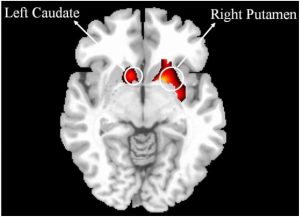Improve Physical and Mental Health during Aging with Mindfulness
By John M. de Castro, Ph.D.
“The healthier and more active one’s lifestyle, the more likely he or she will maintain cognitive performance over time. And meditation may be a key ingredient for ensuring brain health and maintaining good mental performance.“ – Grace Bullock
The aging process involves a systematic progressive decline in every system in the body, the brain included. The elderly frequently have problems with attention, thinking, and memory abilities, known as mild cognitive impairment. An encouraging new development is that mindfulness practices such as meditation training and mindful movement practices can significantly reduce these declines in cognitive ability. In addition, it has been found that
mindfulness practices reduce the deterioration of the brain that occurs with aging restraining the loss of neural tissue. Indeed, the brains of practitioners of meditation have been found to degenerate less with aging than non-practitioners.
In today’s Research News article “Long-Term Physical Exercise and Mindfulness Practice in an Aging Population.” (See summary below or view the full text of the study at: https://www.frontiersin.org/articles/10.3389/fpsyg.2020.00358/full?utm_source=F-AAE&utm_medium=EMLF&utm_campaign=MRK_1832518_a0P58000000G0YfEAK_Psycho_20220317_arts_A&utm_source=sfmc&utm_medium=email&utm_campaign=Article+Alerts+V4.1-Frontiers&utm_term=%%%3d+++++++REDIRECTTO(+++++CONCAT(%27http%3a%2f%2fjournal.frontiersin.org%2farticle%2f%27%2c+TreatAsContent(field(%40article%2c+%27DOI__c%27))%2c+%27%2ffull%3futm_source%3dF-AAE%26utm_medium%3dEMLF%26utm_campaign%3dMRK_%27%2c+TreatAsContent(JobID)%2c+%27_%27%2c+TreatAsContent(%40FieldId)%2c+%27_%27%2c+TreatAsContent(Substring(Replace(Field(%40field%2c+%27Name%27)%2c+%27+%27%2c+%27%27)%2c+0%2c+6))% ) Tang and colleagues compared older adults (average age of 64 years) who were either experienced (> 10 years) meditators or exercisers on physical, mental, immune, stress, and brain plasticity measures.
They report that the older adults who exercised had superior cardiovascular and respiratory fitness. But the older adults who meditated had superior physiological relaxation, quality of life, immune response, stress response, and brain plasticity. They conclude that the optimum results for older adults would be produced by combining meditation and exercise. Regardless, it is clear that meditation restrains the physical and mental deterioration with aging.
“it’s heartening to know that age may not only bring wisdom or sore knees, but also more mindfulness.” – Jenn Director Knudsen
CMCS – Center for Mindfulness and Contemplative Studies
This and other Contemplative Studies posts are also available on Twitter @MindfulResearch
Study Summary
Tang Y-Y, Fan Y, Lu Q, Tan L-H, Tang R, Kaplan RM, Pinho MC, Thomas BP, Chen K, Friston KJ and Reiman EM (2020) Long-Term Physical Exercise and Mindfulness Practice in an Aging Population. Front. Psychol. 11:358. doi: 10.3389/fpsyg.2020.00358
Previous studies have shown that physical exercise and mindfulness meditation can both lead to improvement in physical and mental health. However, it is unclear whether these two forms of training share the same underlying mechanisms. We compared two groups of older adults with 10 years of mindfulness meditation (integrative body-mind training, IBMT) or physical exercise (PE) experience to demonstrate their effects on brain, physiology and behavior. Healthy older adults were randomly selected from a large community health project and the groups were compared on measures of quality of life, autonomic activity (heart rate, heart rate variability, skin conductance response, respiratory amplitude/rate), immune function (secretory Immunoglobulin A, sIgA), stress hormone (cortisol) and brain imaging (resting state functional connectivity, structural differences). In comparison with PE, we found significantly higher ratings for the IBMT group on dimensions of life quality. Parasympathetic activity indexed by skin conductance response and high-frequency heart rate variability also showed more favorable outcomes in the IBMT group. However, the PE group showed lower basal heart rate and greater chest respiratory amplitude. Basal sIgA level was significantly higher and cortisol concentration was lower in the IBMT group. Lastly, the IBMT group had stronger brain connectivity between the dorsal anterior cingulate cortex (dACC) and the striatum at resting state, as well as greater volume of gray matter in the striatum. Our results indicate that mindfulness meditation and physical exercise function in part by different mechanisms, with PE increasing physical fitness and IBMT inducing plasticity in the central nervous systems. These findings suggest combining physical and mental training may achieve better health and quality of life results for an aging population.
